- Accueil
- Institut Néel
- Équipes de recherche
- Pôles & Services techniques
- Travailler à l’institut
- Partenariats
- Actualités
- Agenda
- Annuaire
The QuNES research fields embrace mesoscopic physics, quantum nano-electronics, and surface science. The main topics are electronic properties of 2D materials such as graphene and transition metal dichalcogenides, topological orders in Dirac materials, quantum thermodynamics, hybrid superconducting devices, many-body physics in semiconductor quantum dots and point contacts, and strongly disordered superconductors. The originality of the QuNES team is to combine quantum transport measurements with local probe measurements, using scanning tunneling microscopy and spectroscopy, atomic force microscopy, and scanning gate microscopy, at very low temperature, in ultra high vacuum, and under high magnetic fields.


|
|
Electronic properties of 2D materials |
|
|
Topological phases in Dirac materials |
|
|
Thermodynamics of quantum devices |
|
|
Kondo cloud extension around quantum dots |
|
|
Strongly disordered superconductors |
Pierre Mallet, Jean-Yves Veuillen
Isolated hydrogen atoms absorbed on graphene are predicted to induce magnetic moments. Here we demonstrate, by using STM complemented by first-principles calculations, that the adsorption of a single H atom on graphene induces a magnetic moment characterized by a 20 meV spin-split state at the Fermi energy. By using the STM tip to manipulate H atoms with atomic precision, it is possible to tailor the magnetism of selected graphene regions.
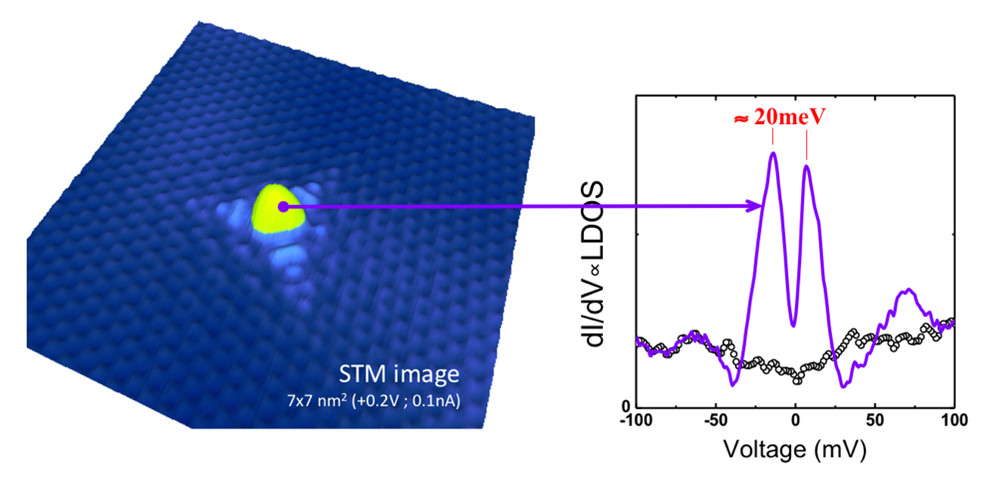
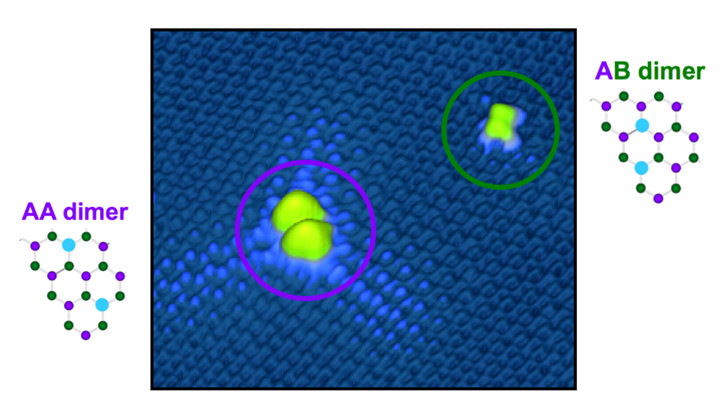
Collaborations :
Universidad Autonoma de Madrid
Publications :
Atomic-scale control of graphene magnetism by using hydrogen atoms, H. Gonzalez-Herrero, J.M. Gomez-Rodriguez, P. Mallet, M. Moaied, J.J. Palacios, C. Salgado, M.M. Ugeda, J.-Y. Veuillen, F. Yndurain, and I. Brihuega, Science 352, 437 (2016)
We performed STM/STS measurements to map the band onsets and the electronic bandgap of 2D semi-conducting TMDs such as WSe2 or MoSe2 deposited on Gr/SiC by mechanical exfoliation or MBE. We analyzed how these electronic properties are tuned by the substrate and by static disorder such as step edges, atomic scale defects, charged impurities, and boundaries.
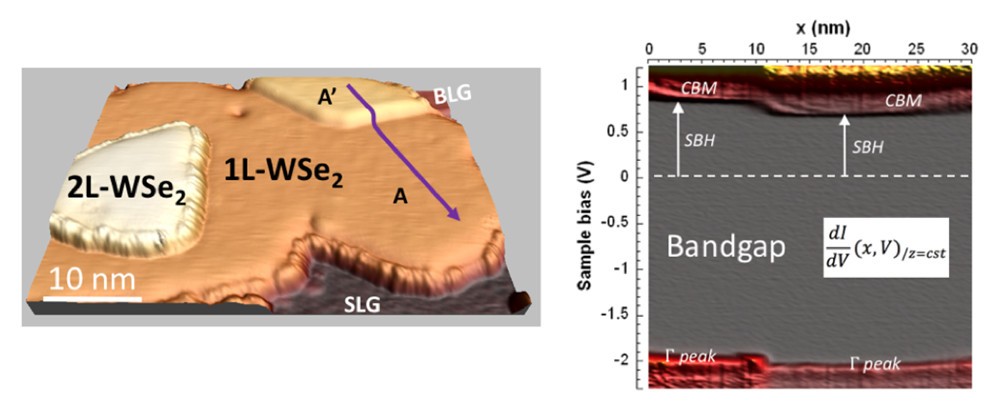
Collaborations :
LNCMI Grenoble
SPINTEC Grenoble
Publications :
Scanning tunneling spectroscopy of van der Waals graphene/semiconductor interfaces: absence of Fermi level pinning, T. Le Quang, V. Cherkez, K. Nogajewski, M. Potemski, M.T. Dau, M. Jamet, P. Mallet, and J.-Y. Veuillen, 2D Materials 4, 035019 (2017)
Band-bending induced by charged defects and edges of atomically thin transition metal dichalcogenide films, T. Le Quang, K. Nogajewski, M. Potemski, M.T. Dau, M. Jamet, P. Mallet, and J.-Y. Veuillen, 2D Materials 5, 035034 (2018)
Benjamin Sacépé, Hermann Sellier
Alexis Coissard, Corentin Deprez, Marco Guerra, Hadrien Vignaud
We unveiled a new interaction-induced topological phase in the zero-th Landau level of graphene. This phase is insulating in the bulk and exhibits a pair of spin-filtered, helical edge channels. It emerges under moderate perpendicular magnetic field when graphene is placed in proximity to a high-k dielectric substrate. In this work we demonstrate a remarkably robust quantum spin Hall effect that withstands up to 110 K over micron-long distances, which opens a new avenue for spintronics and topological superconductivity. More information
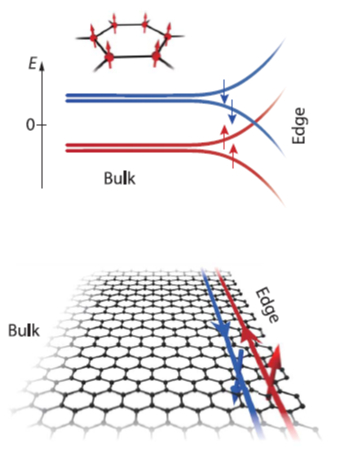
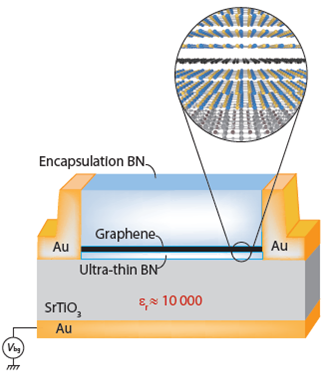
Publications :
Helical quantum Hall phase in graphene on SrTiO3, L. Veyrat, C. Déprez, A. Coissard, X. Li, F. Gay, K. Watanabe, T. Taniguchi, Z. V. Han, B. A. Piot, H. Sellier, and B. Sacépé, Science 367, 781 (2020)
Fundings :
ERC grant QUEST (2015-2020)

The absence of energy gap in graphene at zero magnetic field makes the fabrication of nanostructures difficult using metallic surface gates. In large magnetic fields however, the formation of Landau levels creates gaps in the spectrum, and the conducting edge channels follow the electrostatic potential of the gates. In this regime, quantum point contacts can be realized to control the number of channels transmitted through the device. The graphene flake can also be encapsulated between two boro-nitride flakes to boost its electron mobility. In such an heterostructure, the four-fold degeneracy of the Landau levels is lifted, and the fractional quantum Hall effect has been observed. Thanks to this unprecedented graphene quality, we achieved a precise control of the transmitted current through a quantum point contact, and more complex devices can now be studied, such as quantum Hall interferometers. More information
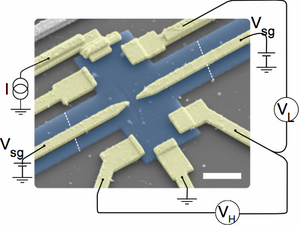
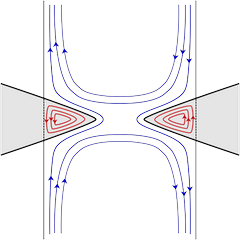
Publications :
Tunable transmission of quantum Hall edge channels with full degeneracy lifting in split-gated graphene devices, K. Zimmermann, A. Jordan, F. Gay, K. Watanabe, T. Taniguchi, Z. Han, V. Bouchiat, H. Sellier, and B. Sacépé, Nature Communications 8, 14983 (2017)
Low-magnetic-field regime of a gate-defined constriction in high-mobility graphene, L. Veyrat, A. Jordan, K. Zimmermann, F. Gay, K. Watanabe, T. Taniguchi, H. Sellier, and B. Sacépé, Nano Letters 19, 635 (2019)
Fundings :
ERC grant QUEST (2015-2020)

Clemens Winkelmann, Hervé Courtois
Danial Majidi, Efe Gumus
Thermal transport in quantum devices is an interesting and yet vastly unexplored topic of research. We carried out thermal transport measurements through a single electron transistor (SET) where theory predicts a violation of some fundamental laws of physics. A thermal gradient is applied across the SET by cooling or heating the source (left) with a biased NIS junction while the drain (right) is thermalized to bath temperature. By measuring the temperature of the source as a function of the applied gate voltage using another NIS junction, we observed a periodic modulation of the heat conductance through the SET that shows a strong deviation from the usual Wiedemann-Franz law relating the charge and heat conductances.
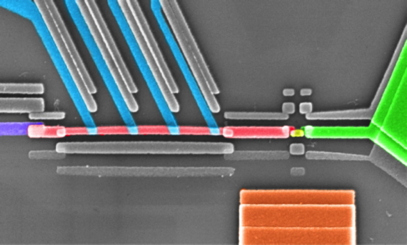
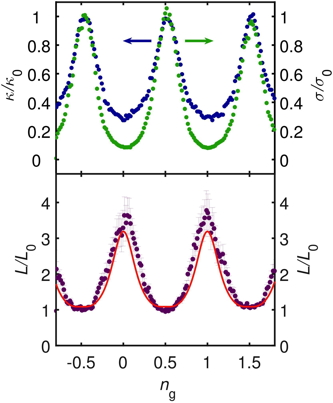
Publications :
Thermal Conductance of a Single-Electron Transistor, B. Dutta, J. T. Peltonen, D. S. Antonenko, M. Meschke, M. A. Skvortsov, B. Kubala, J. König, C. B. Winkelmann, H. Courtois, and J. P. Pekola, Phys. Rev. Lett. 119, 077701 (2017)
Fundings :
Nanosciences Foundation Chair of Excellence of J. P. Pekola
LANEF PhD fellowship of Efe Gumus
Marie Curie ITN project QuESTech
Electron transport through quantum dots coupled to superconducting leads shows a sharp conductance onset when a QD orbital level crosses one of the superconducting coherence peaks. Using individual gold nanoparticles connected to electromigrated aluminum leads, we showed that the hybridization of the QD levels with the leads is strongly enhanced by the divergent density of states at the superconducting gap edge. This result highlights the importance of cotunneling effects in spectroscopies with superconducting probes. In a regime where current is transported through a single level and driven by an ac gate voltage, we demonstrated single-electron-turnstile operation with a very narrow energy distribution and a higher immunity to nonequilibrium quasiparticles of the leads.

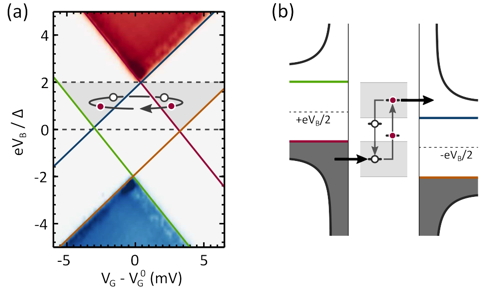
Publications :
Probing hybridization of a single energy level coupled to superconducting leads, D. M. T. van Zanten, F. Balestro, H. Courtois, and C. B. Winkelmann, Phys. Rev. B 92, 184501 (2015)
Single Quantum Level Electron Turnstile, D. M. T. van Zanten, D. M. Basko, I. M. Khaymovich, J. P. Pekola, H. Courtois, and C. B. Winkelmann, Phys. Rev. Lett. 116, 166801 (2016)
Fundings :
Nanosciences Foundation Chair of Excellence of J. P. Pekola
LANEF PhD fellowship of Alvaro Garcia-Corral
Marie Curie ITN project QuESTech
Hermann Sellier, Benjamin Sacépé
Diego Fossion
Gate-defined semiconductor quantum dots represent promising objects for quantum engineering. This project investigates the spatial extension of the many-body Kondo state that develops around these quantum dots at very low temperature. This Kondo cloud is a highly entangled state that could be used to coherently couple remote quantum dots distant by several microns. In this project, we employ scanning gate microscopy, a combined transport and scanning probe experiment, to measure the spatial extension of the Kondo cloud and to probe the Kondo-mediated coherent coupling between two quantum dots.
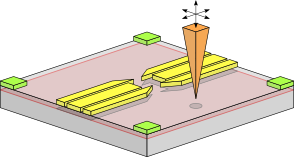
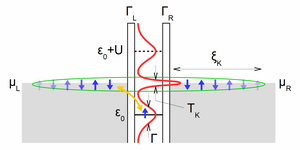
Collaborations :
Serge Florens (NEEL, team ThQC)
Louis Jansen, Marc Sanquer (CEA/INAC, Grenoble, France)
Dominique Mailly, Ulf Gennser (CNRS/C2N, Palaiseau, France)
Benoit Hackens, Vincent Bayot (UCL/IMCN, Louvain, Belgium)
Fundings :
ANR KONEX (2019-2023) KONdo-cloud EXtension around quantum dots
Electron-electron interactions in QPCs give rise to conductance anomalies below the first quantized plateau at 2e²/h, called 0.7 anomaly and zero-bias anomaly. Using scanning gate microscopy, we observed a repetitive splitting of the zero-bias anomaly when the tip approaches the QPC and tune the length of the quasi-1D channel, indicating the formation of a localized electron chain within the constriction, a sort of 1D Wigner crystal. Scanning gate interferometry close to the QPC revealed a phase shift of the electron interference in the bias range of the zero-bias anomaly, interpreted as a signature of localized states in the constriction with Kondo effect. We also introduced a new technique called Thermoelectric Scanning Gate Microscopy to probe quantum phenomena by measuring the thermoelectric voltage across the QPC instead of the conductance. This technique revealed a new phase shift in the tip-induced interference at very low conductance.

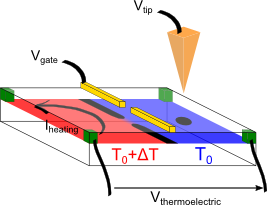
Publications :
Wigner and Kondo physics in Quantum Point Contacts revealed by Scanning Gate Microscopy, B. Brun, F. Martins, S. Faniel, B. Hackens, G. Bachelier, A. Cavanna, C. Ulysse, A. Ouerghi, U. Gennser, D. Mailly, S. Huant, V. Bayot, M. Sanquer, and H. Sellier, Nature Communications 5, 4290 (2014)
Electron Phase Shift at the Zero-Bias Anomaly of Quantum Point Contacts, B. Brun, F. Martins, S. Faniel, B. Hackens, A. Cavanna, C. Ulysse, A. Ouerghi, U. Gennser, D. Mailly, P. Simon, S. Huant, V. Bayot, M. Sanquer, and H. Sellier, Phys. Rev. Lett. 116, 136801 (2016)
Interference features in scanning gate conductance maps of quantum point contacts with disorder, K. Kolasinski, B. Szafran, B. Brun, and H. Sellier, Phys. Rev. B 94, 075301 (2016)
Thermoelectric scanning-gate interferometry on a quantum point contact, B. Brun, F. Martins, S. Faniel, A. Cavanna, C. Ulysse, A. Ouerghi, U. Gennser, D. Mailly, P. Simon, S. Huant, M. Sanquer, H. Sellier, V. Bayot, and B. Hackens, Phys. Rev. Applied 11, 034069 (2019)
Benjamin Sacépé
The interplay between disorder and superconductivity is a fundamental problem of condensed matter physics. Upon increasing disorder or magnetic field it is indeed possible to induce in a thin superconducting film a continuous quantum phase transition from a superconducting state to an insulating state led by the localization of electron pairs. Such zero-temperature transition, which involves Cooper pairs as charge carriers, provides a prototypical system to address the physics of the quantum localization of interacting bosons in disordered media. In this field we mainly focused our research on thin films of amorphous indium oxide, which exhibits a sharp superconductor-to-insulator transition. On the superconducting side of the transition, we have performed in close collaboration with C. Chapelier at INAC, the pioneering mK-STM spectroscopy study of the superconducting gap. Our work has demonstrated that Cooper pairs are not suppressed at the critical disorder but persist in insulators forming localized electron bound pairs. Beyond the critical disorder or critical magnetic field, the insulator that terminates superconductivity is attracting considerable interest due to mounting evidences that the charge carriers in it are electron pairs. In collaboration with D. Shahar from the Weizmann Institute of Science, we have performed magneto-transport studies on thin films. These experiments on insulators focus on the electron-phonon coupling in non-linear transport and on the possible many-body localization of charge carriers in this peculiar insulating state. More information
Position type: Stages Master-2 & Thèse
Contact: Sacépé Benjamin -
Explore the unconventional transport properties of Josephson junctions realized in different quantum Hall states in graphene to push the frontier of this emerging and uncharted field. Perform microwave spectroscopy to characterize and manipulate coherently the topological nature of low-lying excitations.
Position type: Stages Master-2 & Thèse
Contact: Assouline Alexandre -
Anyons are a type of quasiparticle that can be generated in low dimensional (d<3), strongly interacting electronic system. The interest of anyons lies in their new quantum statistics, neither bosonic nor fermionic, which make it possible to manipulate the ground state of an electronic system byexchanging the position of its particles. This controlled exchange of the anyon positions, known as braiding, should lead to topological qubits with exceptionally low error rates. In addition, the possibility of exploring a new quantum statistics beyond the fermion-boson dichotomy is of considerable fundamental interest.
Person in charge: Benjamin SACEPE
Students & Post-docs & CDD
Invited & Others
Alexandre ASSOULINE
Personnel Chercheur - CNRS
alexandre.assouline [at] neel.cnrs.fr
Phone: 04 76 88 78 36
Office: D-306
Hervé COURTOIS
Personnel Chercheur - UGA
Herve.Courtois [at] neel.cnrs.fr
Phone: 04 76 88 11 51
Office: D-305
Benjamin SACEPE
Personnel Chercheur - CNRS
benjamin.sacepe [at] neel.cnrs.fr
Phone: 04 76 88 10 79
Office: D-307
Hermann SELLIER
Personnel Chercheur - UGA
hermann.sellier [at] neel.cnrs.fr
Phone: 04 76 88 10 86
Office: D-418
Jana AWAD
Personnel Chercheur - UGA
jana.awad [at] neel.cnrs.fr
Phone: 04 76 88 70 61
Office: D-318
Referent: Hervé COURTOIS
Nadjib BENCHABANE
Personnel Chercheur - CNRS
nadjib.benchabane [at] neel.cnrs.fr
Office: D-313
Referent: Benjamin SACEPE
Christopher BOSCH
Personnel Chercheur - CNRS
christopher.bosch [at] neel.cnrs.fr
Referent: Alexandre ASSOULINE
Johannes HOFER
Personnel Chercheur - UGA
johannes.hofer [at] neel.cnrs.fr
Phone: 04 76 88 12 24
Office: D-308
Referent: Clemens WINKELMANN
Bilal KOUSAR
Personnel Chercheur - CNRS
bilal.kousar [at] neel.cnrs.fr
Phone: 04 76 88 12 18
Office: D-310
Referent: Benjamin SACEPE
Mohammad MULLA-YUSUF
Personnel Chercheur - CNRS
mohammad.mulla-yusuf [at] neel.cnrs.fr
Office: D-313
Referent: Alexandre ASSOULINE
Xiaoli PENG
Personnel Chercheur - CNRS
xiaoli.peng [at] neel.cnrs.fr
Referent: Benjamin SACEPE
Kalpajit ROY
Personnel Chercheur - CNRS
kalpajit.roy [at] neel.cnrs.fr
Office: D-313
Referent: Benjamin SACEPE
Jashwanth SHAJU
Personnel Chercheur - CNRS
jashwanth.shaju [at] neel.cnrs.fr
Referent: Hermann SELLIER
Wenmin YANG
Personnel Chercheur - CNRS
wenmin.yang [at] neel.cnrs.fr
Phone: 04 76 88 70 16
Office: D-308
Referent: Benjamin SACEPE
Nicolas CHAIZE
Personnel Chercheur - CEA
nicolas.chaize [at] neel.cnrs.fr
Referent: Hermann SELLIER
